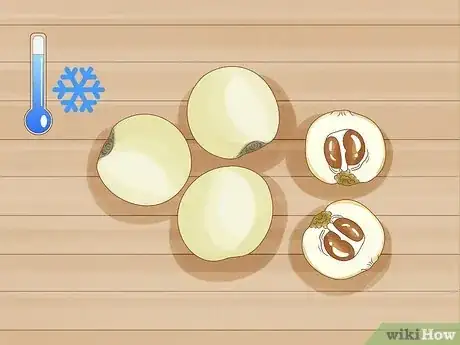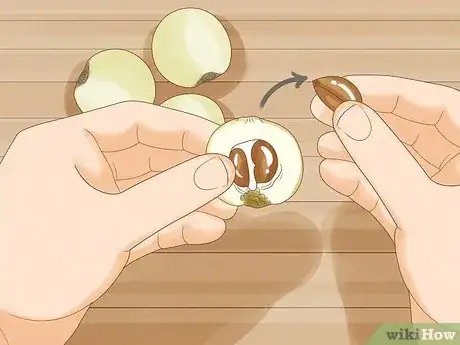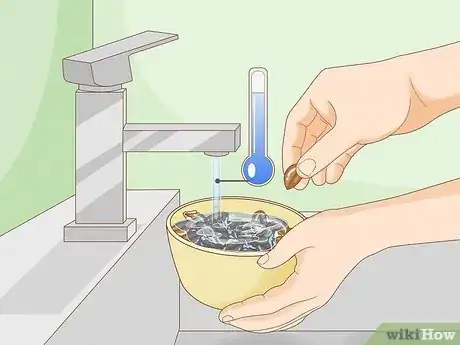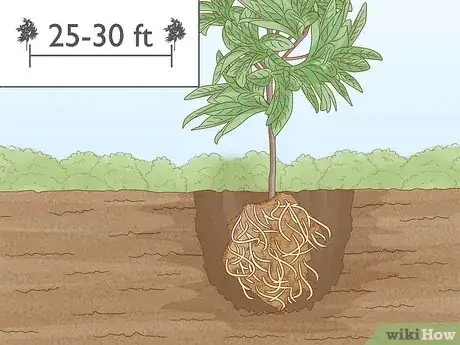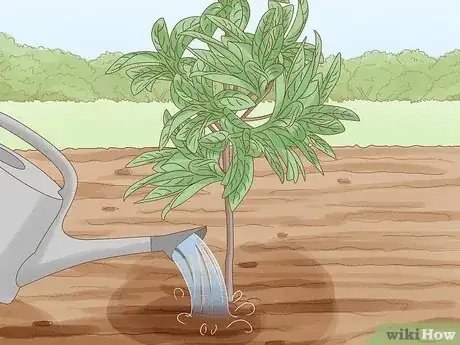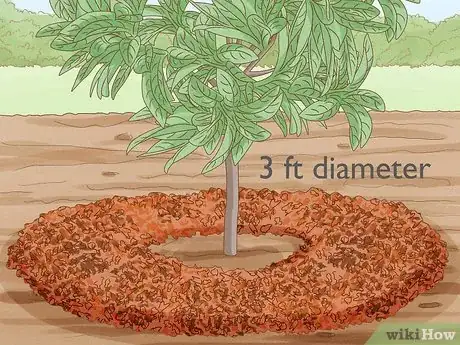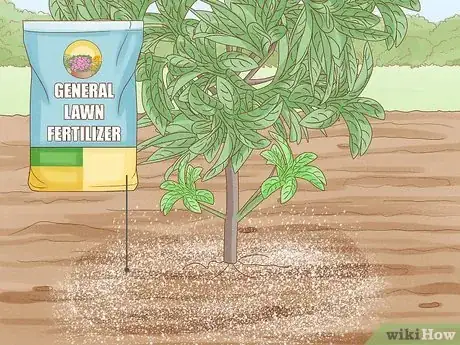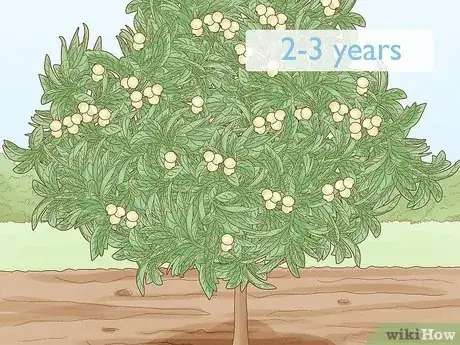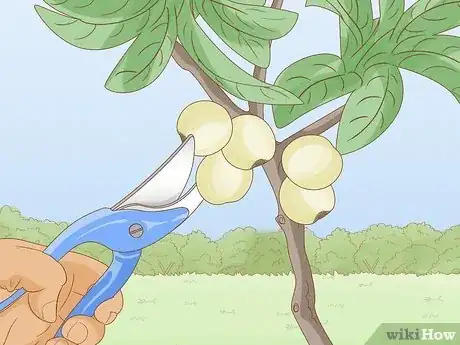X
This article was co-authored by Lauren Kurtz. Lauren Kurtz is a Naturalist and Horticultural Specialist. Lauren has worked for Aurora, Colorado managing the Water-Wise Garden at Aurora Municipal Center for the Water Conservation Department. She earned a BA in Environmental and Sustainability Studies from Western Michigan University in 2014.
This article has been viewed 40,547 times.
A loquat is a type of fruit that tastes somewhat like papayas and guavas. It does better in warmer climates, particularly if you are looking to grow the tree for the fruit, but you can also use it as an ornamental tree. Loquat seeds are fairly easy to germinate, once you remove them from the fruit.
Steps
Part 1
Part 1 of 3:
Saving the Seeds
-
1Choose white-fleshed fruit for cooler climates. If you're wanting to grow a loquat tree in a cooler area, the white-fleshed fruits are a better bet than the orange-fleshed fruit. The white-fleshed fruits also do better in coastal areas.[1]
- Loquats can be found in Asian markets and other exotic fruit stores.
-
2Remove the seeds from the fruit. If you're wanting to grow a tree from fruit you already have, you need to start by pulling the seeds out of the fruit. Most loquats have three to five seeds in them. The seeds are fairly large and brown.[2]
- Some growers caution against growing loquat trees from seeds if you plan on eating the fruit, as you don't know exactly how the fruit will turn out. In fact, it may not produce fruit at all.[3] However, it will make a perfectly fine ornamental plant either way. Purchasing a small sapling is a better idea if you want it to grow fruit.
Advertisement -
3Rinse the seeds off. Make sure all the fruit is off the seeds by removing it with your fingers. Next, run the seeds under cool water, removing any remaining pulp and fruit juice residue.[4]
-
4Buy loquat seeds. Another option for loquat seeds is to purchase them. Your best bet for finding them is an online retailer. For instance, heirloom seed sites or specialty seed stores will likely carry them.
Advertisement
Part 2
Part 2 of 3:
Starting the Seeds
-
1Try a soil-less media. Peat pods work well for growing loquat seeds, which you can buy at your local garden center. Place one seed in each starter.[5] However, the seeds are fairly hardy and will likely germinate in potting soil, as well.
- Loquat seeds won't need to be stratified or scored them like some other seeds do.[6]
- Water the seeds after you plant them in their pots. Keep watering them lightly once a day until they begin sprouting. After that, water the pods when they're dry.
-
2Prepare the soil in the transplant location. When they reach about half a foot, you'll need to transplant the seedlings to a larger pot. You can also transplant them outside if you have mild weather. Loquats can do well in most soils, but you can make the conditions more favorable. Mix in organic material to lightly fertilize the soil. Add in something to improve drainage, such as peat moss.[7]
-
3Transplant them to a larger pot. Make sure the roots are somewhat exposed before replanting. You can turn a hose on the roots if you need to.[8] Place dirt in a larger pot, and gently set the new seedling (with the original media) into the pot. Surround the root system with soil until you reach the base of the plant.
-
4Plant the tree outside. Pick a sunny spot for your tree. Dig a hole that's bigger than the root system, though only slightly. Make sure the roots are partially exposed by turning a hose on them. Set the tree in the ground, and pack the dirt around it.[9]
- If you are planting in a place with mild winters, plant it outside in the fall. If you have colder winters, plant the tree outside in early spring.[10]
- If you are planting more than one tree, it should be planted 25 to 30 feet away from the next loquat tree. If it's a dwarf tree, you may get away with only 13 feet or so apart.
-
5Water the plant. Inside, water the plant when the soil is dry. Outside, water when you put the tree in the ground. After that, water three times a week for at least three to four months, which will help the tree take root.[11]
- Give enough water to soak the roots but don't leave standing water.
Advertisement
Part 3
Part 3 of 3:
Growing the Tree
-
1Mulch around the tree. The tree needs to be free from competition. Therefore, it's best to kill off any vegetation in a 3-foot diameter around the tree. You can use a herbicide to kill off the vegetation. Add mulch after the vegetation dies so you don't have to use herbicide again.[12]
-
2Fertilize when you see new growth. Once the tree is well established outside, it will need fertilizer from time to time. When you see new growth, you can apply a general lawn fertilizer (without a weed killer) to the tree.[13]
- The tree will need 1 cup (240 milliliters) of fertilizer for each year of growth in the first 3 years (1 cup [240 milliliters] in the first year, 2 cups [480 milliliters] in the second year, etc.). However, you should spread it out in three to four applications over the year.
- Once the tree is older, you'll need to use a pound per inch of trunk, spread out over the year.
-
3Expect to wait several years for the tree to bear fruit. If your goal is to get fruit from the tree, you're going to have to wait a while. Fruit may arrive as early as 2 to 3 years after planting.[14] However, it can take as long as a decade for the tree to bear any fruit.
-
4Clip the stalk of the fruit. Loquats are not easy to pull off the tree, even when ripe. To get them off, you'll need to clip off clusters with pruning shears. Otherwise, you may bruise or damage the fruit.[15]
- When it does bear fruit, wait for the fruit to ripen on the tree. These fruits don't ripen well off the tree. Look for the proper color based on the variety you're growing to determine ripeness.
Advertisement
Community Q&A
-
QuestionCan loquat plants grow in containers permanently?
 Sunny MahanandCommunity AnswerIt is possible to grow loquats in containers. These will remain small and compact, and can be placed outdoors when the weather is optimal and moved inside under a bright grow light when the temperatures are too cold.
Sunny MahanandCommunity AnswerIt is possible to grow loquats in containers. These will remain small and compact, and can be placed outdoors when the weather is optimal and moved inside under a bright grow light when the temperatures are too cold.
Advertisement
References
- ↑ http://www.telegraph.co.uk/gardening/3336416/How-to-grow-Loquats.html
- ↑ https://www.hunker.com/12342456/how-to-grow-loquat-trees-from-seeds
- ↑ http://aggie-horticulture.tamu.edu/citrus/loquat.htm
- ↑ https://www.hunker.com/12342456/how-to-grow-loquat-trees-from-seeds
- ↑ https://www.hunker.com/12342456/how-to-grow-loquat-trees-from-seeds
- ↑ http://www.thesurvivalgardener.com/the-long-awaited-gigantic-starting/
- ↑ https://www.hunker.com/12342456/how-to-grow-loquat-trees-from-seeds
- ↑ https://www.hunker.com/12342456/how-to-grow-loquat-trees-from-seeds
- ↑ https://www.hunker.com/12342456/how-to-grow-loquat-trees-from-seeds
- ↑ https://garden.org/learn/articles/view/1576/
- ↑ https://www.hunker.com/12342456/how-to-grow-loquat-trees-from-seeds
- ↑ http://aggie-horticulture.tamu.edu/citrus/loquat.htm
- ↑ http://aggie-horticulture.tamu.edu/citrus/loquat.htm
- ↑ http://aggie-horticulture.tamu.edu/citrus/loquat.htm
- ↑ https://www.hort.purdue.edu/newcrop/morton/loquat.html
About This Article
Advertisement
